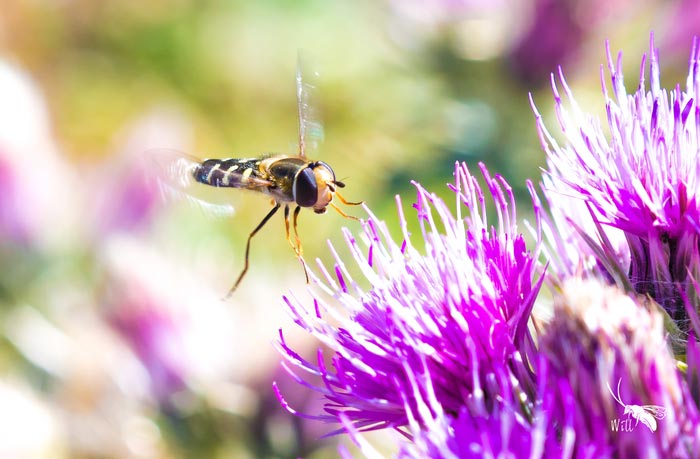Hoverflies navigate using sun and body clock

A pied hoverfly
Credit: Will Hawkes
Hoverflies use a combination of the sun and their body clock to navigate when they fly south for the winter, new research shows.
The insects keep the sun on their left in the morning, then gradually adjust to maintain a southward route as the day goes on.
Pied and yellow-clubbed hoverflies – which are important pollinators – spend their summers in locations such as the UK and Scandinavia, then fly to the Mediterranean and North Africa in autumn.
These migrations are known to happen on sunny days, but the new study – led by the University of Exeter – is the first proof of a “time-compensated sun compass” in hoverflies.
“Simply flying towards the sun would lead them south, but this would create a winding, inefficient route,” said lead author Richard Massy, of the Centre for Ecology and Conservation on Exeter’s Penryn Campus in Cornwall.
“Our study shows that hoverflies account for the sun’s movement using their circadian rhythm.
“Other animals, including certain birds and butterflies, are known to have this ability. Our work suggests that it has independently evolved across multiple insects.”
Researchers caught migrating hoverflies at a mountain pass in the Pyrenees.
The insects were placed in a “flight simulator”, which held them in place but allowed them to swivel freely.
The hoverflies could see the sun but not the ground (meaning they could not navigate using landmarks) and the results showed they headed south by adjusting their course based on the sun’s position and the time of day.
This was further tested by placing some hoverflies in an artificial lighting environment for several days to shift their body clocks, then testing their navigation.
With their circadian rhythm disrupted, their direction of flight shifted westward – supporting the conclusion that they navigate using a time-compensated sun compass.
Dr Karl Wotton, of the University of Exeter, said: “Understanding how these insects navigate can help us predict their movements.
“This could be useful for conservation measures, such as limiting the use of pesticides at key migration times.
“Hoverflies are also important predators of crop pests such as aphids, so understanding their migrations could help us use them as natural pest controllers.”
The research team included the University of Bristol, and funding came from the Royal Society and the Natural Environment Research Council’s GW4 Doctoral Training Programme.
The paper, published in the journal Proceedings of the Royal Society B, is entitled: “Hoverflies use a time-compensated sun compass to orientate during autumn migration.”
Journal: Proceedings of the Royal Society B Biological Sciences
DOI: 10.1098/rspb.2021.1805
Method of Research: Observational study
Subject of Research: Animals
Article Title: Hoverflies use a time-compensated sun compass to orientate during autumn migration.
Article Publication Date: 21-Sep-2021
Media Contact
Louise Vennells
University of Exeter
pressoffice@exeter.ac.uk
Office: 0044-139-272-2062
All latest news from the category: Life Sciences and Chemistry
Articles and reports from the Life Sciences and chemistry area deal with applied and basic research into modern biology, chemistry and human medicine.
Valuable information can be found on a range of life sciences fields including bacteriology, biochemistry, bionics, bioinformatics, biophysics, biotechnology, genetics, geobotany, human biology, marine biology, microbiology, molecular biology, cellular biology, zoology, bioinorganic chemistry, microchemistry and environmental chemistry.
Newest articles

Innovative 3D printed scaffolds offer new hope for bone healing
Researchers at the Institute for Bioengineering of Catalonia have developed novel 3D printed PLA-CaP scaffolds that promote blood vessel formation, ensuring better healing and regeneration of bone tissue. Bone is…

The surprising role of gut infection in Alzheimer’s disease
ASU- and Banner Alzheimer’s Institute-led study implicates link between a common virus and the disease, which travels from the gut to the brain and may be a target for antiviral…

Molecular gardening: New enzymes discovered for protein modification pruning
How deubiquitinases USP53 and USP54 cleave long polyubiquitin chains and how the former is linked to liver disease in children. Deubiquitinases (DUBs) are enzymes used by cells to trim protein…



